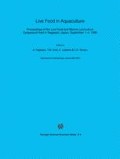Abstract
In order to improve culture stability, as well as to reduce labor and space for mass production of the marine rotifer Brachionus, an automatic continuous culture system has been developed for practical use. The system consists of a filtration unit, a culture unit and a harvest unit. In this system, filtered water and food are continuously supplied into a rotifer culture tank at a pre-determined rate, and the same amount of culture water is transferred into a harvest tank to obtain rotifers at a significant biomass.
B. rotundifonnis (so-called S-type) and B. plicatilis (so-called L-type) were successfully mass-produced from the system, under regulated conditions of 30 °C (for S-type) or 24 °C (for L-type), 20 ppt diluted sea water and total darkness. As food for rotifers, commercially available concentrated fresh water Chlorella vulgaris was used. The dilution rate was adjusted to 0.6–0.7 d−1 for S-type rotifer and 0.25 d−1 for L-type rotifer, respectively. The average production was about 2.1 billion rotifers d−1 from a 1-m3 S-type continuous culture in which high rotifer densities ranging from 3000 to 6000 ind. m1−1 were maintained. On the other hand, about 0.17 billion rotifers d−1 on average were obtained from a 500-liter L-type culture, with densities ranging from 1100 to 2200 ind. ml−1. The longest duration for a continuous culture was over 110 days. Furthermore, experiments utilizing five enrichment techniques indicate that rotifers from the continuous culture system can easily be nutritionally enriched in the same manner as those from common batch culture systems.
Access this chapter
Tax calculation will be finalised at checkout
Purchases are for personal use only
Preview
Unable to display preview. Download preview PDF.
References
Fushimi, T., 1989. Systematizing large scale culture methods. In Fukusho, K. and K. Hirayama (eds), The First Live Feed Source - Brachionus plicatilis. Koseisha-Koseikaku, Tokyo: 118–134. (In Japanese).
James, C. M. and T. Abu-Rezeq, 1989a. Intensive rotifer cultures using chemostats. Hydrobiologia 186 /187: 423–430.
James, C. M. and T. Abu-Rezeq, 1989b. An intensive chemostat culture system for the production of rotifers for aquaculture. Aquaculture 81: 291–301.
James, C. M. and T. Abu-Rezeq, 1990. Efficiency of rotifer chemostats in relation to salinity regimes for producing rotifers for aquaculture. J. aquat. Trop. 5: 103–116.
Kates, M., 1975. Techniques of lipidology. Translated to Japanese by T. Yamakawa, K. Saitho and A. Hayashi, Kagakudoujin, Tokyo: 63–69. (In Japanese).
Nagata, W. D., 1989. Nitrogen flow through a Brachionus/Chlorelle mass culture system. Hydrobiologia 186 /187: 401–408.
Snell, T. W., 1991. Improving the design of mass culture systems for the rotifer, Brachionus plicatilis. In Fulks, W. and K. L. Main (eds), Rotifer and Microalgae Culture Systems, Proceedings of a U.S.–Asia Workshop. The Oceanic Institute, Honolulu, Hawaii: 61–71.
Yoshimura, K., 1995. A high density mass culture system of the rotifer Brachionus rotundiformis (II). Yoshoku, Midorishobo, Tokyo: 116–118. (In Japanese).
Yoshimura, K., K. Usuki, T. Yoshimatsu, C. Kitajima and A. Hagiwara, 1997. Recent development of a high density mass culture system for the rotifer Brachionus rotundiformis Tschugunoff. Hydrobiologia 358: 139–144.
Author information
Authors and Affiliations
Editor information
Rights and permissions
Copyright information
© 1997 Springer Science+Business Media Dordrecht
About this paper
Cite this paper
Fu, Y., Hada, A., Yamashita, T., Yoshida, Y., Hino, A. (1997). Development of a continuous culture system for stable mass production of the marine rotifer Brachionus . In: Hagiwara, A., Snell, T.W., Lubzens, E., Tamaru, C.S. (eds) Live Food in Aquaculture. Developments in Hydrobiology, vol 124. Springer, Dordrecht. https://doi.org/10.1007/978-94-017-2097-7_22
Download citation
DOI: https://doi.org/10.1007/978-94-017-2097-7_22
Publisher Name: Springer, Dordrecht
Print ISBN: 978-90-481-5003-8
Online ISBN: 978-94-017-2097-7
eBook Packages: Springer Book Archive

